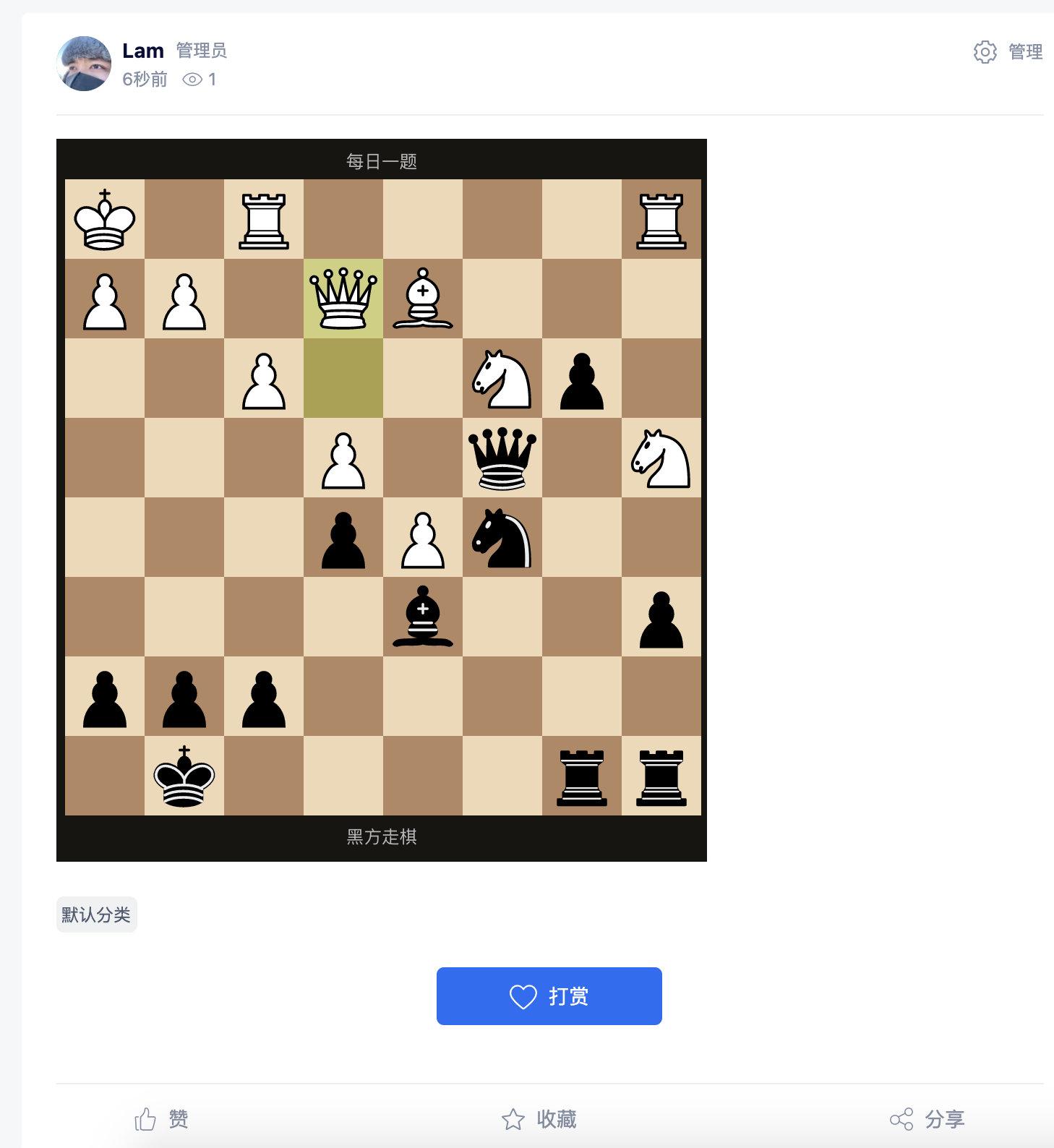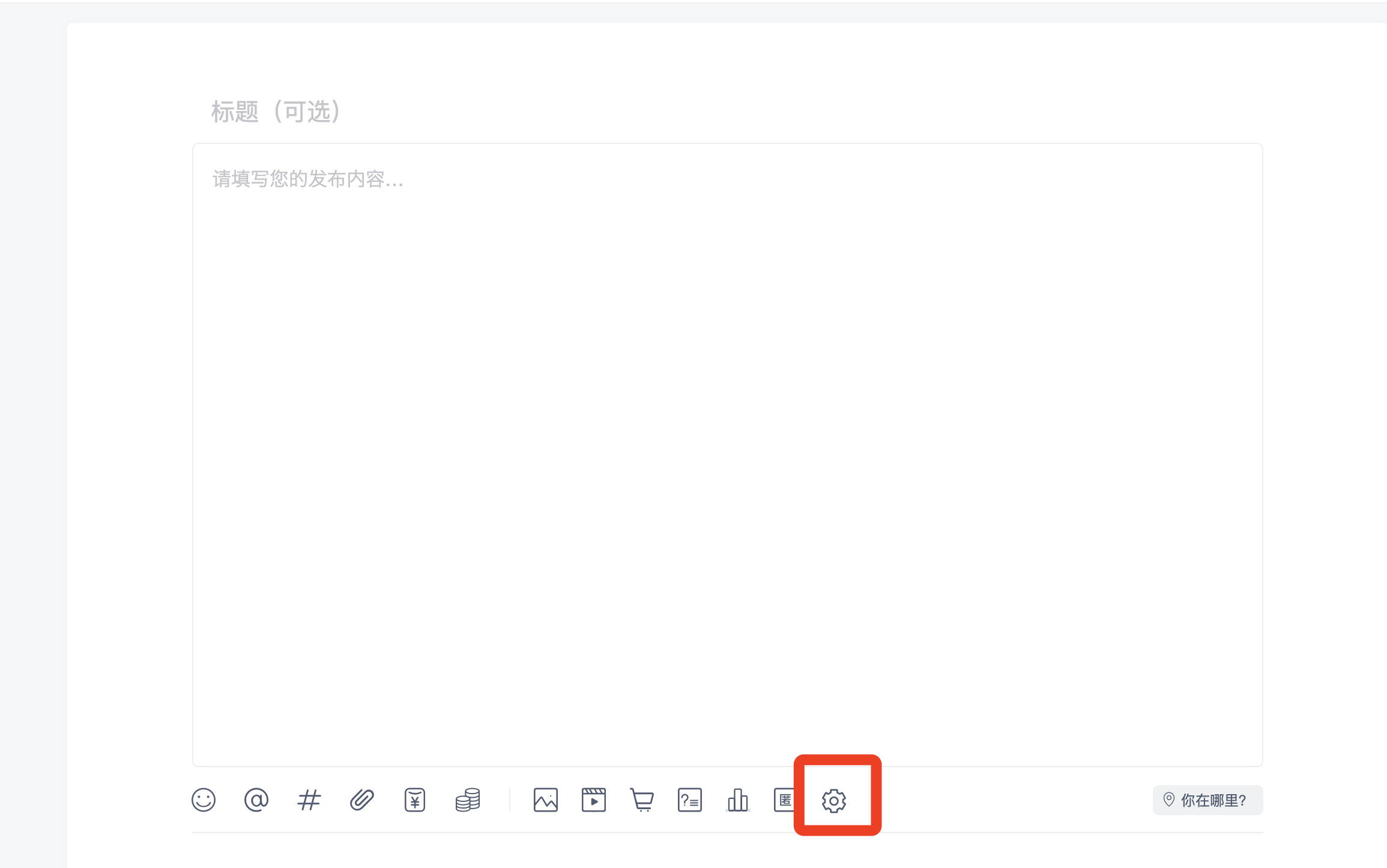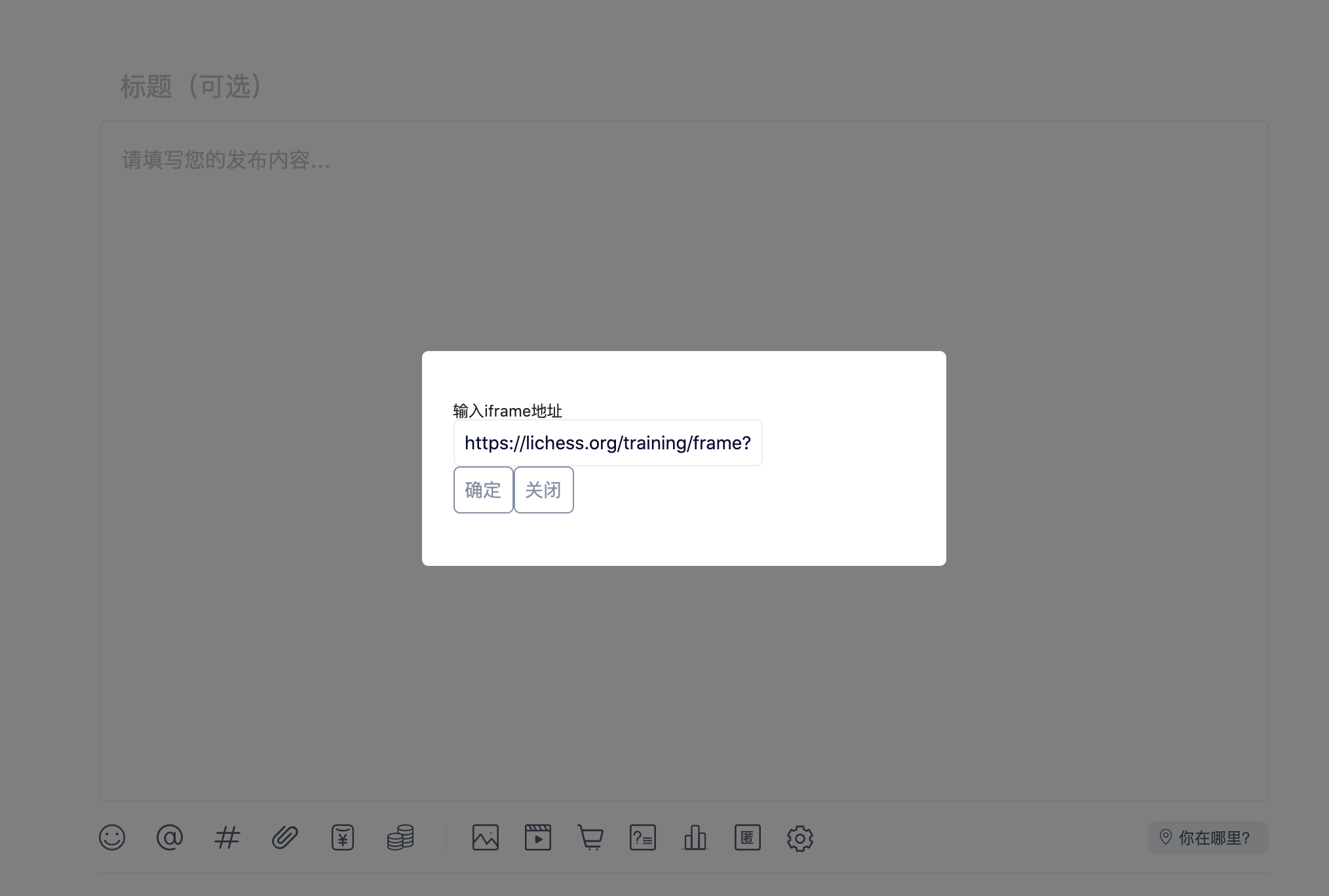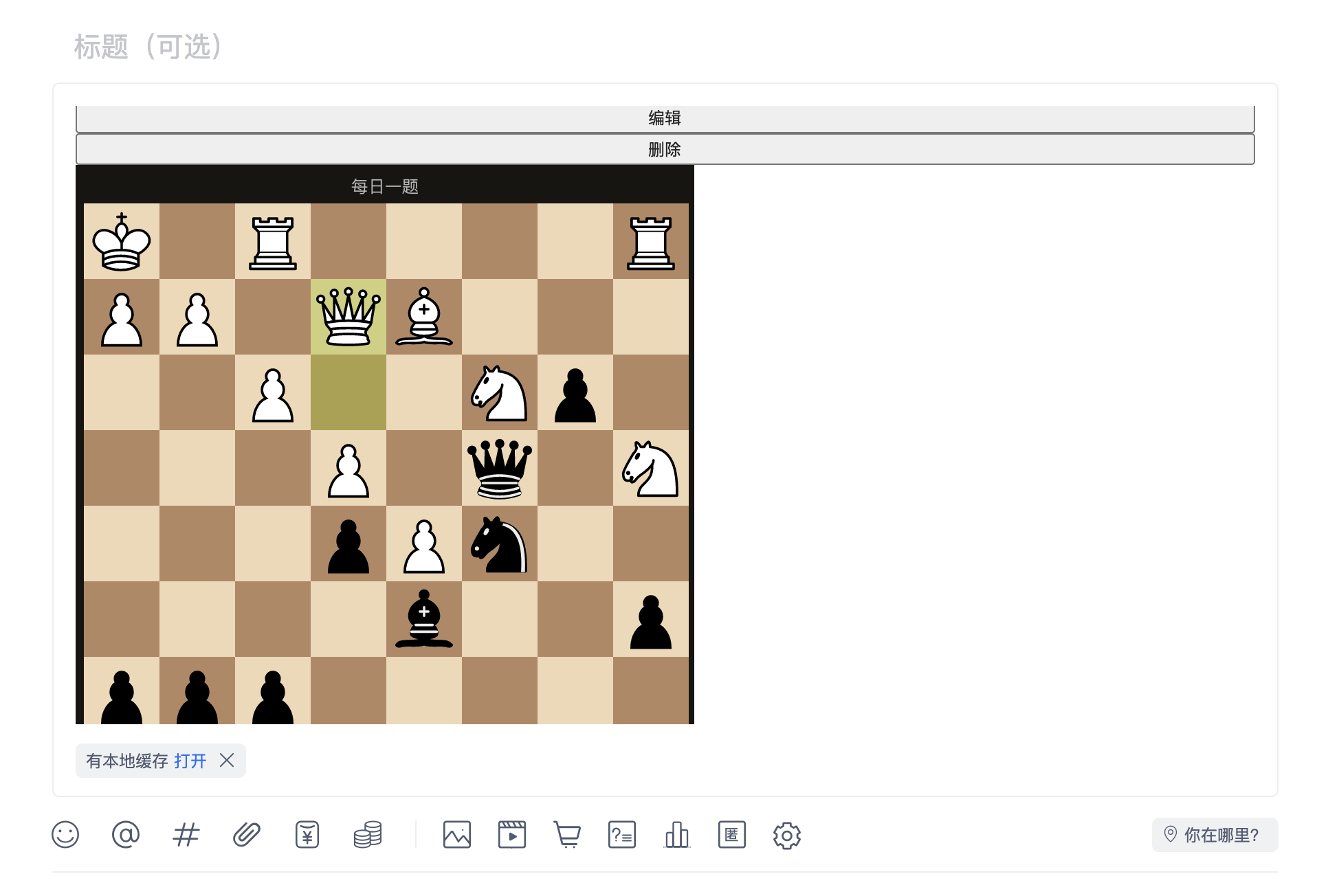开始做一个插件
我们以编写一个简单的存前端插件作为入门示例,此示例属于一个自定义的iframe插件,在发帖时添加一个新的功能,让用户自行输入一个棋盘的链接,最终展示出来。

此功能包含3个插件组成:
- 发帖页扩展功能插件
- 发帖自定义iframe展示插件
- 发布后,帖子展示自定义iframe插件
首先我们在common/plugin目录下创建1个CustomIfream文件夹,根据规范,前端代码需要在client文件中。所以我们还需要在CustomIfream文件夹中新建client文件。
因为我们示例插件涉及到3个插件组成一个完整的功能,所以我们需要分别创建3个插件文件。
- CustomIfream
- CustomIfreamDisplay
- CustomIfreamPost
此刻我们的文件目录结果应该如下:
|- View
| |- src
| | |- CustomIfream
| | | |- ...
| | |- CustomIfreamDisplay
| | | |- ...
| | |- CustomIfreamPost
| | | |- ...
|- config.json以下是每个插件的标准目录规范,后面将不再重复
|- View
| |- src
| | |- CustomIfream
| | | |- adapter
| | | | |- web
| | | | | |- index.jsx
| | | | |- mini
| | | | | |- index.jsx
| | | | |- index.js
| | | |- main.js
| | |- ...
|- config.json默认config.json内容如下:
{
"name_cn":"iframe插件",
"name_en":"CustomIfram",
"description":"...",
"type":9,
"app_id":"...",
"version": "1.0.0",
"status":1,
"filter_enable":false,
"author":{
"name":"...",
"email":"..."
},
"view": {
"CustomIfram": {
"target": "plugin_post",
"hookName": "post_extension_entry_hook",
"platform": ["pc", "h5", "mini"],
"disables": false
},
"CustomIframDisplay": {
"target": ["plugin_index", "plugin_detail"],
"hookName": "thread_extension_display_hook",
"platform": ["pc", "h5", "mini"],
"disables": false
},
"CustomIframPost": {
"target": "plugin_post",
"hookName": "post_extension_content_hook",
"platform": ["pc", "h5", "mini"],
"disables": false
}
}
}接下来我们一个一个组件进行实现。
CustomIfream(发帖页扩展功能插件)
因为我们需要开发一个发帖插件,所以我们需要用到1个taget和1个hook。
- target: plugin_post
- hook: post_extension_entry_hook
plugin_post描述是发帖页面使用,post_extension_entry_hook描述插件在功能扩展区使用。
首先编写我们的主程序文件。 main.js
import Component from './adapter';
import config from '../../../config.json';
export default class CustomIframPost {
static pluginName = config.name_en // 插件名称
static version = config.version // 插件版本
static author = config.author
static platform = config.view.CustomIfram.platform;
static target = config.view.CustomIfram.target // 插件使用目标
static hookName = config.view.CustomIfram.hookName // 钩子名称
static component = <Component/> // 需要渲染的组件
static options = {} // 需要在注入时提供的额外数据
}接着我们进入adapter目录,编写入口文件
adapter/index.js
let pluginComponent = () => {};
if (process.env.DISCUZ_ENV === 'mini') {
// taro项目的小程序
pluginComponent = require('./mini/index.jsx');
}
if (process.env.DISCUZ_ENV === 'web') {
pluginComponent = require('./web/index.jsx');
}
export default pluginComponent.default;然后我们分别编写小程序和浏览器的具体组件实现。
adapter/web/index.jsx(浏览器)
import React from 'react';
import { Icon, Dialog, Button, Input } from '@discuzq/design';
export default class CustomIfram extends React.PureComponent {
constructor(props) {
super(props);
this.state = {
visible: false
}
}
render() {
return (
<>
<Icon
onClick={e => {
e.stopPropagation();
this.setState({
visible: true
})
// handleAttachClick(e, item);
// trggerInput(item);
}}
name='SettingOutlined'
size="20"
/>
<Dialog
visible={this.state.visible}
>
输入iframe地址
<Input value='https://lichess.org/training/frame?theme=brown&bg=dark'/>
<Button onClick={() => {
this.props.onConfirm({
postData: {
tomId: 900001,
body: {
url: 'https://lichess.org/training/frame?theme=brown&bg=dark'
}
}
});
this.setState({
visible: false
})
}}>确定</Button>
<Button onClick={() => {
this.setState({
visible: false
})
}}>关闭</Button>
</Dialog>
</>
)
}
}adapter/mini/index.jsx (小程序)
import React from 'react';
import { Icon, Dialog, Button, Input } from '@discuzq/design';
import { View } from '@tarojs/components';
export default class CustomIfram extends React.PureComponent {
constructor(props) {
super(props);
}
render() {
return (
<>
<Icon
onClick={e => {
e.stopPropagation();
this.props.showPluginDialog(
<View>
输入iframe地址
<Input value='https://lichess.org/training/frame?theme=brown&bg=dark'/>
<Button onClick={() => {
this.props.onConfirm({
postData: {
tomId: 900001,
body: {
url: 'https://lichess.org/training/frame?theme=brown&bg=dark'
}
}
});
this.props.closePluginDialog();
}}>确定</Button>
<Button onClick={() => {
this.props.closePluginDialog();
}}>关闭</Button>
</View>
);
}}
name='SettingOutlined'
size="20"
/>
</>
)
}
}自此,我们已经完成了1/3的插件开发了。这是我们可以在web目录下运行npm run dev,启动来看看效果。

点击按钮的效果:

点击确定后,发现并没有任何效果展示,那是因为我们并没有为编辑器的钩子添加上对应的插件。
CustomIfreamPost(发帖自定义iframe展示插件)
我们接着开发一个发帖时,编辑器内容区的插件,所以我们需要用到1个taget和1个hook。
- target: plugin_post
- hook: post_extension_content_hook
plugin_post描述是发帖页面使用,post_extension_content_hook描述插件在编辑器的扩展内容区。
首先编写我们的主程序文件。 main.js
import Component from './adapter';
import config from '../../../config.json';
export default class CustomIframPost {
static pluginName = config.name_en // 插件名称
static version = config.version // 插件版本
static author = config.author
static platform = config.view.CustomIframPost.platform;
static target = config.view.CustomIframPost.target // 插件使用目标
static hookName = config.view.CustomIframPost.hookName // 钩子名称
static component = <Component/> // 需要渲染的组件
static options = {} // 需要在注入时提供的额外数据
}接着我们进入adapter目录,编写入口文件
adapter/index.js
let pluginComponent = () => {};
if (process.env.DISCUZ_ENV === 'mini') {
// taro项目的小程序
pluginComponent = require('./mini/index.jsx');
}
if (process.env.DISCUZ_ENV === 'web') {
pluginComponent = require('./web/index.jsx');
}
export default pluginComponent.default;然后我们分别编写小程序和浏览器的具体组件实现。
adapter/web/index.jsx(浏览器)
import React from 'react';
import { Icon, Dialog, Button, Input } from '@discuzq/design';
export default class CustomIframPostContent extends React.PureComponent {
constructor(props) {
super(props);
this.state = {
}
}
render() {
const { _pluginInfo, renderData, deletePlugin, updatePlugin } = this.props;
if ( !renderData ) {
return null;
}
const { body, tomId } = renderData;
const { url } = body;
return (
<div style={{display: 'flex', 'flexDirection': 'column'}}>
<button onClick={() => {
updatePlugin({
postData: {
tomId,
body: {
url: 'https://baidu.com',
}
}
})
}}>编辑</button>
<button onClick={() => {deletePlugin()}}>删除</button>
<iframe src={url} width='450' height='500'></iframe>
</div>
)
}
}adapter/mini/index.jsx (小程序)
import React from 'react';
import { Icon, Dialog, Button, Input } from '@discuzq/design';
import { View, Text } from '@tarojs/components';
export default class CustomIframPostContent extends React.PureComponent {
constructor(props) {
super(props);
this.state = {
}
}
render() {
const { _pluginInfo, renderData, deletePlugin, updatePlugin } = this.props;
if ( !renderData ) {
return null;
}
const { body, tomId } = renderData;
const { url } = body;
return (
<View style={{display: 'flex', 'flexDirection': 'column'}}>
<Button>编辑</Button>
<Button onClick={() => {deletePlugin()}}>删除</Button>
<Text>{url}</Text>
</View>
)
}
}自此,我们已经完成了1/3的插件开发了。这是我们可以在web目录下运行npm run dev,启动来看看效果。

这是时候我们发布帖子,正常情况下是能发布成功,但是我们回到首页,会发现对应刚刚发的帖子的内容没有展示出来,这个时候我们就要开发一个在帖子内容区的插件了。
CustomIfreamPost(发布后,帖子展示自定义iframe插件)
我们接着开发一个发布后,帖子展示自定义iframe插件,所以我们需要用到2个taget和1个hook。
- target: 【plugin_index, plugin_detail]
- hook: thread_extension_display_hook
plugin_index和plugin_detail描述是帖子列表和详情页面,thread_extension_display_hook描述插件在帖子扩展内容区展示。
首先编写我们的主程序文件。 main.js
import Component from './adapter';
import config from '../../../config.json';
export default class CustomIframPost {
static pluginName = config.name_en // 插件名称
static version = config.version // 插件版本
static author = config.author
static platform = config.view.CustomIframDisplay.platform;
static target = config.view.CustomIframDisplay.target // 插件使用目标
static hookName = config.view.CustomIframDisplay.hookName // 钩子名称
static component = <Component/> // 需要渲染的组件
static options = {} // 需要在注入时提供的额外数据
}接着我们进入adapter目录,编写入口文件
adapter/index.js
let pluginComponent = () => {};
if (process.env.DISCUZ_ENV === 'mini') {
// taro项目的小程序
pluginComponent = require('./mini/index.jsx');
}
if (process.env.DISCUZ_ENV === 'web') {
pluginComponent = require('./web/index.jsx');
}
export default pluginComponent.default;然后我们分别编写小程序和浏览器的具体组件实现。
adapter/web/index.jsx(浏览器)
import React from 'react';
export default class CustomIframDisplayContent extends React.PureComponent {
constructor(props) {
super(props);
this.state = {
}
}
render() {
const { _pluginInfo, renderData, siteData } = this.props;
if ( !renderData ) {
return null;
}
const { body, tomId } = renderData;
const { url } = body;
return (
<div style={{display: 'flex', 'flexDirection': 'column'}}>
<iframe src={url} width={siteData.platform === 'pc' ? '450' : '100%'} height='500'></iframe>
</div>
)
}
}adapter/mini/index.jsx (小程序)
import React from 'react';
import { View, Text } from '@tarojs/components';
export default class CustomIframDisplayContent extends React.PureComponent {
constructor(props) {
super(props);
this.state = {
}
}
render() {
const { _pluginInfo, renderData, siteData } = this.props;
if ( !renderData ) {
return null;
}
console.log('mini', renderData);
const { body, tomId } = renderData;
const { url } = body;
return (
<View>
<Text>{url}</Text>
</View>
)
}
}自此,我们已经完成了插件的开发。这是我们可以在web目录下运行npm run dev,启动来看看效果。

到这里一个简单的自动以ifream插件已经开发完成。
通过本地编译,将插件代码放入Discuz !Q前端仓库中的common/plugin,然后编译就可以看到你的插件生效了。
